The following is a guest post by Margo Seltzer, Herchel Smith Professor of Computer Science at Harvard School of Engineering and Applied Science. Her collaborators were Regina Herzlinger of Harvard Business School and Kevin Schulman of Duke University School of Medicine.
A computer scientist, doctor, and business professor all walked into a MOOC…
Well, not exactly, but it is not far off from the HarvardX MOOC on healthcare innovation organized by Regina Herzlinger of Harvard Business School and featuring domain experts such as Dr. Kevin Schulman of Duke and me.
Called “Innovating in Healthcare,” our goal was to engage participants in “evaluating opportunities and the elements of viable business models for different kinds of health care innovations.”
In fact, the relationship between Health and IT was one of CCC’s past visioning activities.
We simultaneously ran the course as both a MOOC and a smaller, limited enrollment format for a sub-set of learners. The SPOC, or “Small” (500 students) Private Online Course, provided an opportunity for like-minded students to self-assemble into teams using a matching algorithm (we are happy to provide more details on that to anyone interested).
The virtual teams, many comprised of international participants, collaborated to tackle a challenging healthcare problem, namely by coming up with a business plan that could spur innovation. The global participation (see Table 1) was exciting, resulting in team composition that couldn’t have happened any other way.
The very design of the course was a perfect case study related to a key question raised at a CCC workshop held last year, “Multidisciplinary Research for Online Education,” namely: the “synchronous and asynchronous interaction within and between local and global learning communities and the ways that these communities might evolve into other forms of collaboration and competition.”
In offering a MOOC in which we wanted students to engage in small team work, we joined a distinguished group of colleagues, such as Marti Hearst (UC Berkeley), Scott Klemmer (UC San Diego), and Rob Miller (Massachusetts Institute of Technology) — see a synopsis of their presentation at this year’s Snowbird: http://cra.org/uploads/documents/events/snowbird/2014slides/CS_Research_on_MOOC.pdf.
Being directly involved in developing and teaching a MOOC gave me a “close encounter of a new kind” — one that I would encourage my colleagues in CS to experience as well. Having had the summer to reflect, here are a few of the key takeaways that I hope will spur further innovations in CS, healthcare and IT, and other fields.
Design with engagement in mind. We all know that MOOC engagement levels plummet soon after launch. We found that the retention and activity rate for our SPOC was far higher (75% versus less than 10%) than what we observe in other classes. Herzlinger was exceedingly generous with her time, providing a strong presence throughout the run of the MOOC and SPOC. She was present, monitoring with her team, responding, and engaging, and that that made a big difference, based upon student feedback.
In addition, we were able to facilitate the creation of small global teams thanks to the ability to reach so many learners at once. Such cross-talk is not only essential for innovation (providing multiple perspectives and experiences), but seems to encourage true teamwork and ongoing engagement.
Play an active learning long game. Most important we gave the team something to do — an active learning element. As a result, many of the teams (76 of 100) produced high quality business plans. The fact that the teams, primarily self-motivated, produced such outstanding work struck all of us as tremendously exciting. We are now continuing to work with some of the teams who are planning to start companies based on their plans.
While we are not sure how they will all turn out in the long run, we are energized by the promise of the MOOC/SPOC combination to push innovation in areas such as healthcare. Beyond completion rates, credit, or the traditional markers of success, imagine if the newest flavor of open online learning courses result in new businesses, inventions, or meaningful connections that last a lifetime.
Rinse and repeat. Moving ahead we are examining ways to improve the learning experience in subsequent editions of the course.
MOOCs may become a fertile testing ground for small group interaction studies and could blossom into learning laboratories in the same way that the data-driven data sites like OkCupid have become testbeds for human behavior.
Moreover, I think we were most surprised and gratified that active-learning is indeed possible in MOOCs: and it requires little more than engaging instructors, a way to facilitate teams, and, of course something meaningful to do.












Health
care – Health Care news and background. Articles are providing about
healthcare, affordable health care, health care, health insurance, Assurant
Affordable health care, healthcare, health care, health insurance, assurant health
This is
a nice post. For getting more information about Health
Care news and background. Articles are providing about healthcare, affordable
health care, health care, health insurance, Assurant go
Health care.
Affordable health care ,
Health insurance,
Star plus serials
Assurant health
Health
Innovation Entrepreneurship application focused towards sustainable innovation
approach to health. Display is important that the definitions and concepts that
include innovation, design, entrepreneurship, and Six Sigma principles and
organizational improvement process and the law of patents, and market forces
that affect the health innovation process.